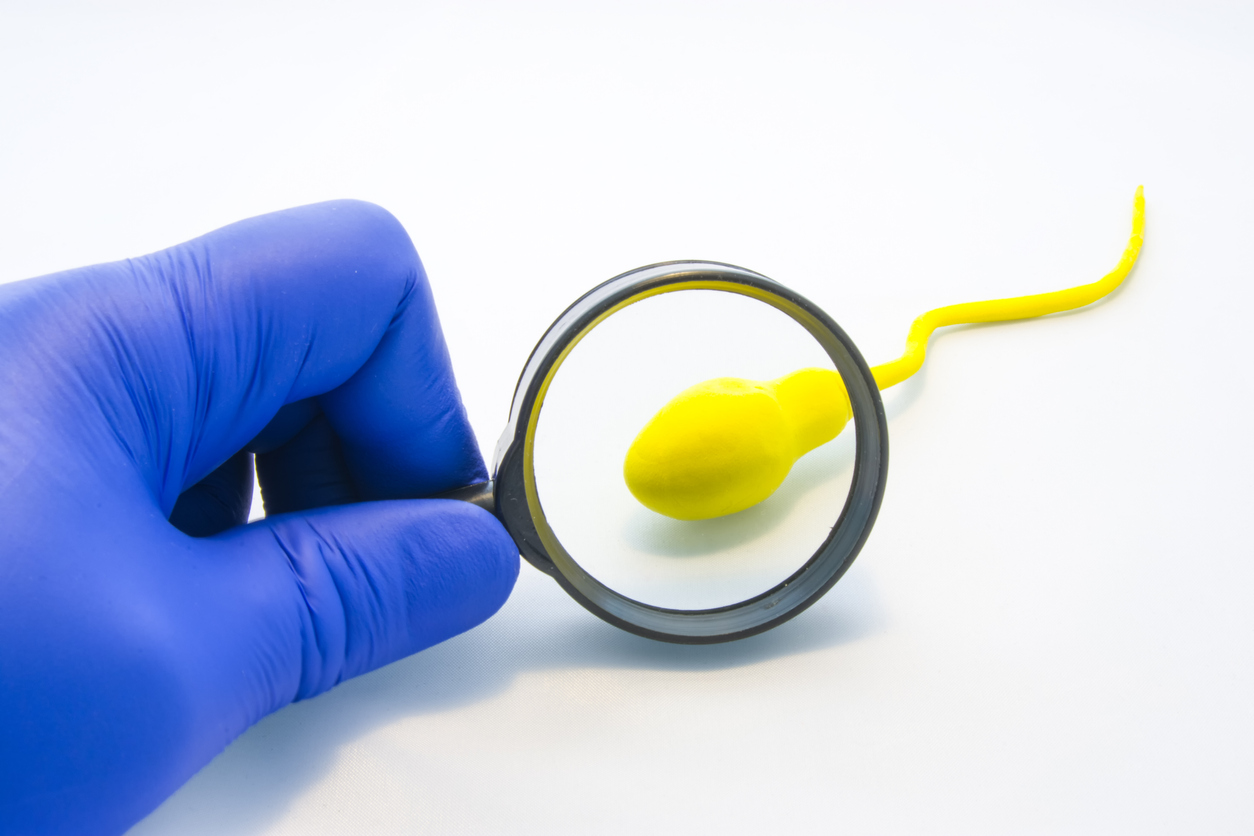Couples having trouble conceiving will likely be advised to evaluate the male partner’s fertility by getting a semen analysis test. This noninvasive test measures the quantity and quality of semen and sperm. This isn’t a thrilling prospect for most men because the actual process is a little awkward and the possibility of having a fertility issue can also be daunting. The numbers are also concerning, with 60% of couples experiencing infertility having a male factor involved. However, considering how complicated infertility testing can be for women, a semen analysis is a relatively routine way to start investigating.
So, what exactly does a semen analysis entail?
We start with the patient’s role in the analysis: specimen production. Sample collection should be done after 2-4 days of abstaining from ejaculation, which includes both masturbation and sex, and then abstaining for this window of time after which the sample is collected. Analysis is done on semen produced from one ejaculate. Ideally, the collection should be on-site, at the lab where the analysis will be done. However, this isn’t always possible; whether it’s feeling pressure or just being uncomfortable, many men cannot produce in a clinical setting. Rest assured that in these cases, sample production can be done in the comfort of your home. The specimen should then be transported within the hour, keeping it at body temperature under a jacket or shirt, to the facility for analysis.
Another tricky aspect of collection is getting the entire sample into the sterile collection cup. To minimize loss, you should have the cup open before starting and be standing or sitting at the time of collection. Finally, for those who don’t masturbate, for cultural and other personal reasons, collection can be done using a collection condom. The condom is free of spermicide, is used during intercourse and, after ejaculation, tied off, placed in a sterile cup, and transported to the facility for analysis.
Now that collection is completed, how much is enough?
It’s time for the lab to take over and analysis to begin, but did you produce enough and isn’t it usually more? Firstly, most of the important testing can be done with just one drop of semen. Second, seeing the specimen in a cup is a perspective that you are not used to and, therefore, it may look less than normal. Finally, if you are worried about the amount as a result of missing collection of the sample, this should be reported to the lab, and rescheduling the analysis should be considered.
The lab has your specimen, what are they doing with it?
Well, nothing shady I can assure you. We start by allowing the semen to liquefy in an incubator set at body temperature. Semen is a viscous semifluid, very thick and clumpy after ejaculation. Exposure to body temperature allows it to thin and become fluid. The consistency usually changes within 10-60 minutes, and samples that don’t will need to be thinned using a needle and syringe to disperse mucus. These samples are considered to have increased viscosity, and this is usually reported. In the vagina, at body temperature, if the semen remains viscous, sperm will have difficulty swimming freely and breaking through the fluid. So, liquefaction and viscosity are a great test of how the ejaculate will behave in the vagina. After this, we check the volume of the semen, or the actual quantity ejaculated; the normal here is 2 milliliter (mL). For comparison, this is just less than half a teaspoon. The color is also reported at this time. It should be white to yellow, as any red or brown may signify blood in the semen, which is unusual. A few drops are then loaded onto special count slides designed for semen analysis under the microscope. Before getting into the actual sperm, under the microscope a great deal of debris and other round inclusions can be seen. So, what are they?
These round cells are typically junk, immature sperm, or white blood cells. In cases of blood in semen, there could be red blood cells as well. A count is done to determine the round cell concentration and if it is too high, staining of the sample is done to determine what percentage of these round cells are white blood cells. If increased viscosity and/or white blood cell concentration are significant, it may indicate an infection or inflammation. Agglutination or clumping of sperm in patches and streaks, observed under the microscope, is another indication of infection. Follow up semen analysis with cultures may be suggested in these cases to determine if the findings are indeed significant and determine specific causes.
Now you know about the other stuff in there, what about your swimmers?
Sperm is the male sex cell that carries half of the DNA needed for reproducing and making your very own offspring. Under the count slides mentioned before, a determination of sperm concentration can be made. This is the measure of how many million sperm there are in each milliliter of semen. The average sperm concentration is more than 60 million sperm per milliliter of the ejaculate, with a count of less than 20 million sperm per milliliter of the ejaculate being considered sub-fertile. The motility is also calculated. This number represents the percentage of sperm that are moving. In a sample, we would like 50% or more of the total sperm to be motile. There are also degrees on how motile these sperm are. This quality of movement is judged as forward progression. In general, they should be moving forward and not stuck in place twitching. This can be slow and undirected to extremely fast and moving directly forward. Using sperm concentration and motility, the total motile count (TMC) of the sample can be calculated, which indicates the amount of moving sperm in the entire ejaculate. There should be more than 40 million motile sperm in the ejaculate.
It seems like everything is covered, is that it?
No, in routine semen analysis there are two more basic tests done. The first being morphology, which describes the shape of the sperm. There are two general methods used for analyzing morphology, Kruger Morphology also known as strict morphology and WHO Morphology which is more lenient. They both have their guidelines for sperm shape assessment. In both, 100 sperm are assessed, and the percentage considered to be normal under each guideline is reported. Low percentage morphology in any of the criteria could translate to difficulty in conceiving. The last basic test done is anti-sperm antibody testing. Sperm are tested to see if they react to small immunobeads, if a significant percentage does, this could mean that self-produced antibodies against your own sperm are present and it could impede fertility.
How about now, that has to be it?
In routine semen analysis, these are the basic tests done. There are a few additional specialized tests done in response to the results seen in these basic tests, but those are for another discussion.
If you’d like more information on semen analyses or male infertility, contact us


